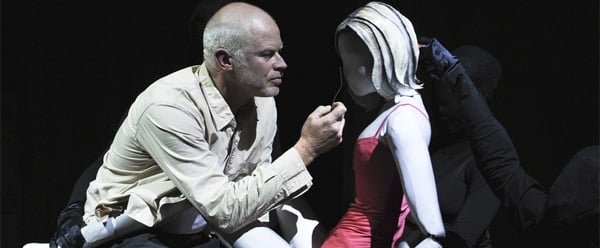Home | Blog | Interview with Katina Olsen – Murder
Interview with Katina Olsen – Murder
I was lucky enough to score a ticket to one of the most exciting shows in the 2013 Sydney Festival line-up. It is a dark and racy work mapping the inner machinations of the malevolent mind which also touches (albeit briefly) on the extremity of maternal instinct. A surprisingly beautiful work, expertly crafted and at times poignant, which wouldn’t normally be associated with so hideous a theme. I’m talking about local company Erth’s production, Murder and even better- performer Katina Olsen agreed to share some insights onto the working process.
How did you get involved?
It began with an audition for Erth while I was working for Tess De Quincey in No Cold Feet. They were last year with touring and needed back up. They do a lot of children’s shows, working with indigenous themes (I bunyip and Nargun and the Stars), and are well known for their big dinosaur puppets.
When did you realise this wasn’t a regular puppet show, if there is a regular puppet show?
Straight from the start of the first creative development.
How long was the rehearsal process?
First development was 3 weeks where we workshopped the ideas and the final rehearsal was 5 weeks, so 8 weeks all up. Raimondo Cortese, the writer, and Scott Wright had already come in with a script and we started improvising around that. It was continually developing and evolving. It was very collaborative.
How did you start the working day?
We would start with a physical warm-up, each of us taking it turn, sharing the load. Because I am a dancer I would do a more standard, movement based one that started with floor work consisting of yoga poses that focused on core strength. I wanted to make sure everything was grounded, held together, so I don’t get puppeteer shoulders but I suppose that’s inevitable because I’m right handed. (I wanted to ask about the relevance of developing puppeteer shoulders and right handedness, but was pumping questions like a bull-at-a-gate and didn’t give her, or I, the chance to explain. I still have much to learn when it comes to successful interviewing techniques.)
Graeme (Rhodes), the actor, gave a really good warm up based on exercises he did with a theatre group. They were part of the Stanislavsky approach. We would all work in a circle, it involved a lot of breathing exercises and was very repetitive, a bit like MB (Muscle and Bone), but we had to maintain focus with the person standing opposite us in the circle.
Do you think it was necessary to have a choreographer? What was it like working with Kate Champion?
Scott Wright, the director, would set the scene and say, “I want this”, while Kate would suggest how to make the image stronger.
It was good to have an outside eye. Gavin (Clarke, another puppeteer/cast member) and I both have movement backgrounds and would work with Kate to help embody the characters. She would help us with blocking because we had to stay behind the puppets while interacting with Graeme. It was Kate’s idea that we should manipulate Graeme like one of the puppets at the beginning. It felt more like partnering, more like what I’m familiar with. Kate suggested I handcuff Graeme at one point and had to teach me how to be more butch.
Sometimes we would try things with our own bodies first, to work out the mechanics and then make the puppet do it. Altogether, we would embody them. It was subtle. Scott wanted me to be an extension of Candy (female puppet) by wearing a dress and moving in unison with her, for instance when Candy goes to the fridge, I would do the same and add a kick to hips like her.
How did it feel to be a part of the more graphic scenes?
Sometimes it was uncomfortable at first, but that’s acting.
What was the response from your friends and family?
They were generally impressed with my puppeteering skills. Yolande Brown (Bangarra dancer) said she saw a lot of me in the way they moved.
Mum was focussing more on the puppets but said to me afterwards, “I just closed my eyes Kat. I’m all right.” She said it felt too real.
What were your favourite parts?
Stagger Lee was a favourite because we manipulated the puppets to music. It was more choreographed. I would be thinking “I have to move my head on that count.”
The boy section at the end was good because I worked with Rod Primrose. Gavin and I had less puppeteering skills and Rod would give us basic instruction, encouraging us to add our own personal input. The boy just sees another boy murdered by his mum and when he was questioned I would nod and shake his head like a four year old would, big and energetic. He gets enthusiastic when Graeme mentions fairies but then recoils when he mentions ghosts. This is something I had a big hand in developing.
When I create a work I want to incorporate many skills. I really enjoy what it (this project) has taught me. I have been inspired by different ideas and the people. This project has definitely influenced how I will make work in the future.
Follow Vicki on FORM’s Twitter – https://twitter.com/formdance

